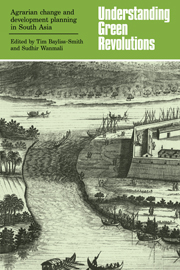Book contents
- Frontmatter
- Contents
- List of contributors
- Preface
- I Understanding Green Revolutions: an overview
- II Agrarian change at village level
- 5 Agrarian policy and agrarian change in tribal India
- 6 Migration and agrarian change in Garhwal District, Uttar Pradesh
- 7 Agricultural development in Tamil Nadu: two decades of land use change at village level
- 8 Energy flows and agrarian change in Karnataka: the Green Revolution at micro-scale
- 9 Income and wealth disparities in a land settlement of the Sri Lanka Dry Zone
- 10 Agrarian structure and agricultural innovation in Bangladesh: Panimara village, Dhaka district
- 11 A structural analysis of two farms in Bangladesh
- III Development planning and agrarian change
- Index
11 - A structural analysis of two farms in Bangladesh
Published online by Cambridge University Press: 25 May 2010
- Frontmatter
- Contents
- List of contributors
- Preface
- I Understanding Green Revolutions: an overview
- II Agrarian change at village level
- 5 Agrarian policy and agrarian change in tribal India
- 6 Migration and agrarian change in Garhwal District, Uttar Pradesh
- 7 Agricultural development in Tamil Nadu: two decades of land use change at village level
- 8 Energy flows and agrarian change in Karnataka: the Green Revolution at micro-scale
- 9 Income and wealth disparities in a land settlement of the Sri Lanka Dry Zone
- 10 Agrarian structure and agricultural innovation in Bangladesh: Panimara village, Dhaka district
- 11 A structural analysis of two farms in Bangladesh
- III Development planning and agrarian change
- Index
Summary
This chapter examines the structure of two farms in Bangladesh, and the structure of knowledge associated with those farms, a structure which varies according to the perspective of the viewer. To do this, it uses a methodology which is as yet not well known – hence much of this chapter must be given to the technicalities of the methodology. Some readers might prefer less on the methodology and more on the case study, but I ask them to be patient, since some of the descriptive statements can only be understood if the methodology itself is grasped. But let it be stated emphatically that the motivation for developing new methodology comes from the desire to understand the world better, and in this case the great need to understand better the farmers and farms of Bangladesh, so that improvements can be introduced faster and less destructively.
The study in context
Within the field of agricultural studies this chapter falls within the focus of several themes. Firstly, although there is much talk of bottom-up development, most development is top-down, inevitably so, if one remembers that those that enounce bottom-up are in fact at the top. The methods of western science have been applied in the research stations of the developing countries, and the results transmitted down or out to the farmers. A bottomup approach would have to begin with seeing how the farmers themselves see things, and by hearing their needs and priorities. Which citizens’ advice bureau in the West begins by telling its prospective customers what their problems are?
- Type
- Chapter
- Information
- Understanding Green RevolutionsAgrarian Change and Development Planning in South Asia, pp. 212 - 250Publisher: Cambridge University PressPrint publication year: 1984



